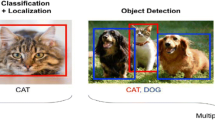Abstract
Moving object detection and tracking from video sequences are a relevant research field since it can be used in many applications. While detection allows to return object shapes discovered in the image, tracking aims to individually identify and estimate individual trajectories of detected objects over time. Hence, detection can have a crucial impact on the overall tracking process. This paper focuses on detection. Currently, one of the leading detection algorithms includes frame difference method (FD), background subtraction method (BS), and optical flow method. Here, we present a detection algorithm based on the first two approaches since it is very adequate for fast real-time treatments, whereas optical flow has higher computation cost due to a dense estimation. A combination of FD and BS with Laplace filters and edge detectors is a way to achieve sparse detection fast. Thus, a main proposed contribution is the achievement of a systematic detection algorithm for moving target detection with a more elaborated combination of basic procedures used in real-time surveillance. Experimental results show that the proposed method has higher detection accuracy and better noise suppression than the current methods for standard benchmark datasets.













Similar content being viewed by others
Notes
References
Luo W, Xing J, Milan A, Zhang X, Liu W, Zhao X, Kim TK. Multiple object tracking: a literature review. ArXiv Journal; 2014. arXiv:1409.7618.
Hu WC, Chen CH, Chen TY, Huang DY, Wu ZC. Moving object detection and tracking from video captured by moving camera. J Vis Commun Image Represent. 2015;30:164–80.
Yazdi M, Bouwmans T. New trends on moving object detection in video images captured by a moving camera: a survey. Comput Sci Rev. 2018;28:157–77.
Baek I, Davies A, Yan G, Rajkumar RR. Real-time detection, tracking, and classification of moving and stationary objects using multiple fisheye images. In: 2018 IEEE intelligent vehicles symposium (IV). IEEE; 2018. p. 447–52.
Lee C, Moon JH. Robust lane detection and tracking for real-time applications. IEEE Trans Intell Transp Syst. 2018;19(12):4043–8.
Hu HN, Cai QZ, Wang D, Lin J, Sun M, Krahenbuhl P, Yu F. Joint monocular 3D vehicle detection and tracking. In: Proceedings of the IEEE international conference on computer vision; 2019. p. 5390–9.
Henschel R, Leal-Taixe L, Cremers D, Rosenhahn B. Fusion of head and full-body detectors for multi-object tracking. In: Proceedings of the IEEE conference on computer vision and pattern recognition workshops; 2018. p. 1428–37.
Shotton J, Blake A, Cipolla R. Contour-based learning for object detection. In: Tenth IEEE international conference on computer vision (ICCV’05), vol. 1. IEEE; 2005. p. 503–10.
Tu Z, Xie W, Zhang D, Poppe R, Veltkamp RC, Li B, Yuan J. A survey of variational and CNN-based optical flow techniques. Signal Process Image Commun. 2019;72:9–24.
Zhang L, Liang Y. Motion human detection based on background subtraction. In: 2010 Second international workshop on education technology and computer science, vol. 1. IEEE; 2010. p. 284–7.
Zhong Z, Zhang B, Lu G, Zhao Y, Xu Y. An adaptive background modeling method for foreground segmentation. IEEE Trans Intell Transp Syst. 2016;18(5):1109–21.
Zhang Y, Wang X, Qu B. Three-frame difference algorithm research based on mathematical morphology. Proc Eng. 2012;29:2705–9.
Wang Q, Gao J, Yuan Y. Embedding structured contour and location prior in siamesed fully convolutional networks for road detection. IEEE Trans Intell Transp Syst. 2017;19(1):230–41.
Dosovitskiy A, Fischer P, Ilg E, Hausser P, Hazirbas C, Golkov V, Van Der Smagt P, Cremers D, Brox T. Flownet: learning optical flow with convolutional networks. In: Proceedings of the IEEE international conference on computer vision; 2015. p. 2758–66.
Niu L, Jiang N. A moving objects detection algorithm based on improved background subtraction. In: 2008 eighth international conference on intelligent systems design and applications, vol. 3. IEEE; 2008. p. 604–7.
Zhan C, Duan X, Xu S, Song Z, Luo M. An improved moving object detection algorithm based on frame difference and edge detection. In: Fourth international conference on image and graphics (ICIG 2007). IEEE; 2007. p. 519–23.
Weng M, Huang G, Da X. A new interframe difference algorithm for moving target detection. In: 2010 3rd international congress on image and signal processing, vol. 1. IEEE; 2010. p. 285–9.
Gang L, Shangkun N, Yugan Y, Guanglei W, Siguo Z. An improved moving objects detection algorithm. In: 2013 International conference on wavelet analysis and pattern recognition. IEEE; 2013. p. 96–102.
Liu H, Dai J, Wang R, Zheng H, Zheng B. Combining background subtraction and three-frame difference to detect moving object from underwater video. In: OCEANS 2016-Shanghai. IEEE; 2016. p. 1–5.
Yuan Y, Xiong Z, Wang Q. VSSA-NET: vertical spatial sequence attention network for traffic sign detection. IEEE Trans Image Process. 2019;28(7):3423–34.
Brutzer S, Höferlin B, Heidemann G. Evaluation of background subtraction techniques for video surveillance. In: CVPR 2011. IEEE; 2011. p. 1937–44.
Toyama K, Krumm J, Brumitt B, Meyers B. Wallflower: principles and practice of background maintenance. In: Proceedings of the seventh IEEE international conference on computer vision, vol. 1. IEEE; 1999. p. 255–61.
Fernandez-Sanchez EJ, Rubio L, Diaz J, Ros E. Background subtraction model based on color and depth cues. Mach Vis Appl. 2014;25(5):1211–25.
Andreatos AS, Zagorianos A. Matlab GUI application for teaching control systems. In: Proceedings of the 6th WSEAS international conference on engineering education; 2009. p. 208.
Cui B, Creput JC. Matlab GUI application for moving object detection and tracking. In: International symposium on distributed computing and artificial intelligence. Cham: Springer; 2018. p. 353–6.
Acknowledgements
This work was supported by China Scholarship Council (201604490109).
Author information
Authors and Affiliations
Corresponding author
Ethics declarations
Conflict of Interest
The authors declare that they have no conflict of interest.
Additional information
Publisher's Note
Springer Nature remains neutral with regard to jurisdictional claims in published maps and institutional affiliations.
Rights and permissions
About this article
Cite this article
Cui, B., Créput, JC. A Systematic Algorithm for Moving Object Detection with Application in Real-Time Surveillance. SN COMPUT. SCI. 1, 106 (2020). https://doi.org/10.1007/s42979-020-0118-5
Received:
Accepted:
Published:
DOI: https://doi.org/10.1007/s42979-020-0118-5




